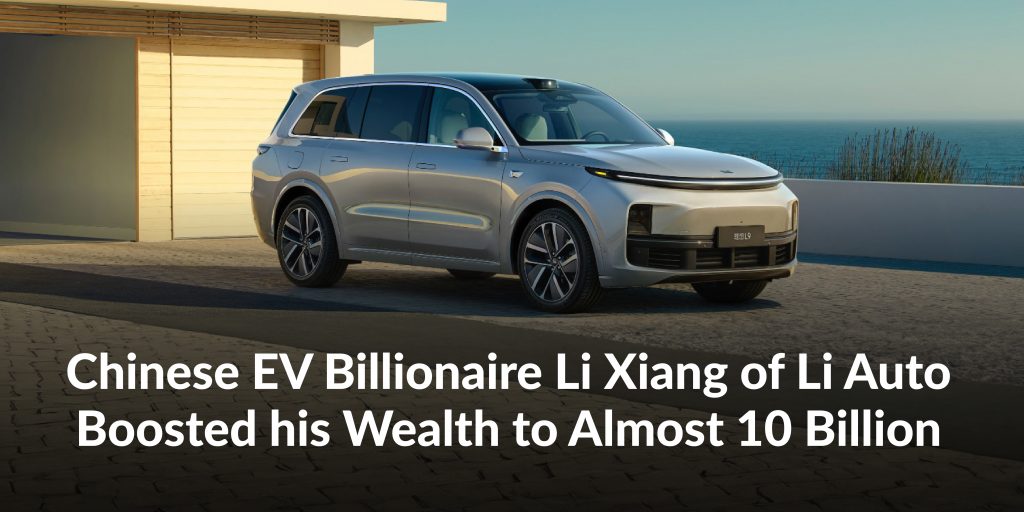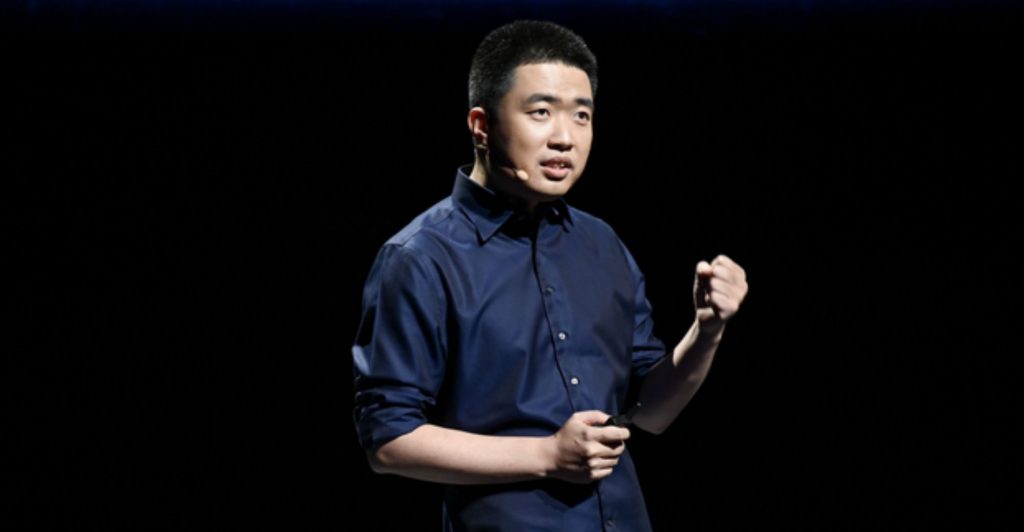
Li Xiang, founder, chairman, and CEO of Chinese electric vehicle manufacturer, Li Auto, saw a jump in his wealth from $1.5 billion to almost $10 billion last Monday, ranking Li Xiang as one of the five biggest wealth gainers worldwide, according to Forbes’s real-time billionaire list. How? By cutting the prices of their EVs in order to gracefully fight in the cutthroat competition of the EV market in China. The investors have approved of his price cutting strategy which led to smart, actionable implementation, driving through the fierce competition. Li Xiang is proving that these price cuts have compromised Li Auto’s bottom line. Although, analyst experts say that Li Auto’s strategy of consolidating the price war against its competitors might graze its margin eventually.

EV China Market Overview
In 2023, 25% of New Car Sales in China were electric vehicles. The Chinese electric vehicle (EV) market concluded the year on a high note, achieving a remarkable milestone with a 46% year-over-year (YoY) growth in the final month, totaling a record-breaking 980,000 units sold. Notably, the growth of fully electric vehicles (BEVs) was comparatively slower, increasing by only 31% to reach 618,000 units. Despite this, BEVs still dominated the market, accounting for 63% of the plugin market in December. This figure marked a slight decline from the 66% average seen throughout 2023 and was notably lower than the 2022 final result of 74%.
The top 20 leading selling electric vehicles in China in 2023 were: (from highest to lowest)
| Rank | Vehicle | # of sold cars in December 2023 |
| 1 | BYD Song Pro/Plus (PHEV+BEV) | 72,182 |
| 2 | Tesla Model Y | 60,055 |
| 3 | BYD Qin Plus (BEV+PHEV) | 41,142 |
| 4 | BYD Seagull | 41,012 |
| 5 | BYD Yuan Plus | 30,799 |
| 6 | Wuling Bingo | 27,458 |
| 7 | BYD Dolphin | 26,814 |
| 8 | AITO M7 EREV | 25,545 |
| 9 | Wuling HongGuang Mini EV | 25,015 |
| 10 | GAC Aion Y | 22,678 |
| 11 | Li Xiang L7 | 20,428 |
| 12 | BYD Han (BEV+PHEV) | 19,832 |
| 13 | Tesla Model 3 | 15,750 |
| 14 | GAC Aion S | 15,216 |
| 15 | Li Xiang L8 | 15,013 |
| 16 | Li Xiang L9 | 14,913 |
| 17 | WW ID.3 | 13,201 |
| 18 | BAIC EU-Series | 12,811 |
| 19 | BYD Tang (BEV+PHEV) | 12,807 |
| 20 | Geely Panda Mini | 12,538 |
| OTHERS | 455,528 | |
| TOTAL | 980,737 |
According to Yahoo Finance, in 2024, China’s EV growth is protected to grow in 2024. Research by Rystad Energy forecasts 17.5 million EV sales this year, an 18.5% annual increase. As a result, the share of new car sales that are either battery electric (BEV) or plug-in hybrid electric vehicles (PHEV) will increase from 19.2% in 2023 to around 21.8% at the end of 2024.
What is Li Auto?
Li Auto, founded by Li Xiang in 2015, is an electric vehicle (EV) manufacturer headquartered in Beijing, China, with manufacturing facilities in Changzhou. Specializing in electric vehicles with range extender technology, Li Auto made its debut on the NASDAQ stock market in 2020 under the ticker symbol “LI,” securing $1.1 billion in initial financing. Despite strong sales and popularity in the Chinese market, the company struggled to raise sufficient funds from investors in its first year on the stock exchange, closing with only 70% of its targeted financing.
In 2022, Li Auto underwent a significant portfolio overhaul, introducing a new design language and expanding its model range from the existing Li One SUV to three entirely new designs. The flagship model, Li L9, premiered in March, followed by the shorter Li L8 variant and the smaller Li L7 model in September. The Li L7 is the entry-level model, lacking a third row of seats. Additionally, in September 2022, Li Auto announced the discontinuation of the Li One production, drawing criticism from recent buyers of the hybrid SUV.
Where Did the Price-Cutting War on EVs Begin?
The automotive sector has traditionally been characterized by its heavy reliance on capital investment, with manufacturers aiming for economies of scale to drive profitability. The price-cutting war on China’s EV competitive market was led by Tesla last year. Tesla’s cuts its price on their Model 3 (by 6%) and Model Y by (11%) EVs to lead as a premium EV segment in the fast-growing and competitive market of EVs in China, according to Junheng Li, Capital CEO and Head of Research of JL Warren, written by CNBC. This led to EV market competitors following the price-cutting trend.
How Did Li Auto Adapted to the Price-Cutting War on EVs?
Amidst this price-cutting war back in March 2023, chairman, founder, and CEO, Li Xiang, announced that Li Auto will resist joining its competitors in the price-cutting war of EVs. Instead, they announced and introduced price guarantee or “price protection” on its electric vehicles, promising to refund the price difference if prices decrease within 90 days of placing non-refundable orders, written by Technode.
This implies that if Li Auto reduces its prices, individuals who purchased vehicles at higher prices will receive compensation.
Despite showing no interest in the price-cutting war and announcing its “price protection” program, a few months later, Li Auto stealthy joined the price-cutting war on EVs in China in August 2023 as the orders slowed down. Despite having no official announcement, the clever move done by Li Auto, buyers in Sichuan Province received a government subsidy of 10,000 yuan and a maintenance fund of 5,000 yuan. Li Auto’s policy of allowing buyers to offset invoices from other locations extends this discount to car buyers nationwide.
In January 2024, Li Auto offered discounts on EVs ranging from RMB 35,000 to RMB 38,000 (US$ 4,866.11 to US$ 5283.21) to EV models of Li L7, Li L8, and Li L9, according to WallstreetCN.
What is a Price-Cutting Strategy?
A price-cutting strategy can be applicable to all types of businesses. It is a strategy that involves reducing the prices of products or services in order to attract customers and gain a competitive advantage in the market. This approach can be implemented by various types of businesses across different industries. By offering lower prices than competitors, companies aim to increase their market share, stimulate sales, and potentially drive out rivals
How to Implement a Price-Cutting Strategy
implementing a price-cutting strategy requires careful consideration of factors such as cost structure, target market, and long-term profitability to ensure sustainable success. Additionally, businesses may need to monitor market dynamics and adjust their pricing strategy accordingly to remain competitive and profitable over time.
- Market Research and Analysis
Conduct market research to understand competitors’ pricing strategies, customer preferences, and market trends.
Analyze the company’s cost structure, including manufacturing, distribution, and overhead expenses.
- Identify Target Market Segments
Identify target customer segments that are price-sensitive and value-conscious, such as budget-conscious consumers, environmentally conscious households, and small businesses looking to reduce costs.
- Set Clear Objectives
Define specific objectives for the price-cutting strategy, such as increasing market share, attracting new customers, or stimulating sales growth.
- Cost Reduction Measures
Explore opportunities to reduce costs without compromising product quality or sustainability standards. This may include sourcing materials from cheaper suppliers, optimizing manufacturing processes, or renegotiating contracts with vendors.
- Price Adjustment
Determine the extent of price reduction based on competitive analysis, cost considerations, and desired profit margins. The price cut should be significant enough to attract attention but still sustainable for the business.
- Communication and Marketing
Develop a compelling marketing campaign to communicate the value proposition of the price-cutting strategy. Emphasize the affordability, quality, and environmental benefits of EcoTech’s products compared to competitors.
Utilize various marketing channels such as social media, email newsletters, and targeted advertising to reach potential customers and drive traffic to the company’s website or retail stores.
- Monitor and Evaluate
Monitor the impact of the price-cutting strategy on sales, profitability, and market share. Use key performance indicators (KPIs) such as revenue growth, customer acquisition cost, and customer retention rate to assess the effectiveness of the strategy.
Gather feedback from customers and stakeholders to identify areas for improvement and make necessary adjustments to the pricing strategy over time.
How did the Price-Cutting Strategy Benefited Li Auto?
Li Auto reported that the gross margin for the fourth quarter of 2023 rose to 23.5%, up from 20.2% in the same period of 2022 and 22% in the third quarter of 2023. Li Auto’s shares soared to nearly 12% to 46.21 in big volume on the stock market as of February 27, 2024, according to Investors Business Daily.
Another report from Investopedia, Li Auto’s American Depositary Receipts (ADRs) experienced a significant surge on Monday following impressive performance by the Chinese electric vehicle (EV) maker. Despite facing stiff competition in its home market, Li Auto managed to surpass expectations by reporting its first annual profit.









